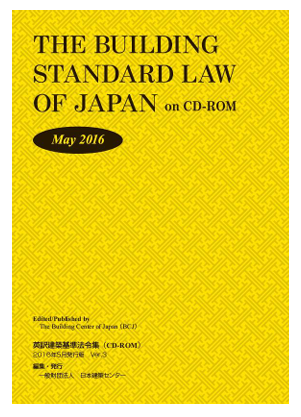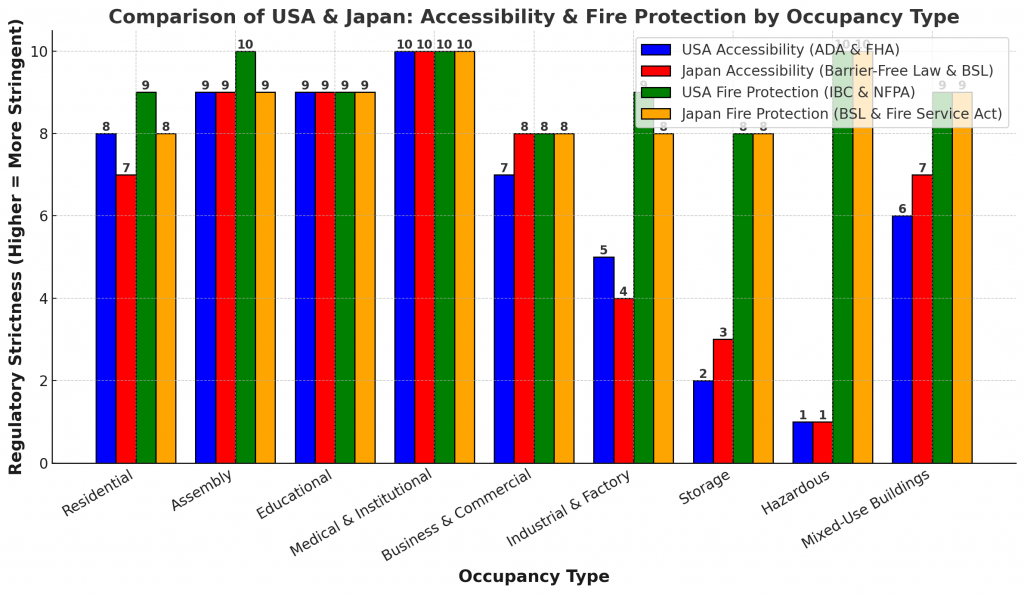
United States – International Building Code (IBC)
- The International Building Code (IBC) is the primary model building code in the United States, developed by the International Code Council (ICC).
- While it serves as a national standard, local jurisdictions (states and cities) often adopt and modify it.
Application:
- Local jurisdiction adoption: Most states and cities adopt a version of the IBC, often with amendments.
- Third-party inspection & approval: Includes plan review, permits, and inspections by licensed professionals.

Japan – Building Standard Law (BSL)
- Japan has some of the world’s strictest seismic codes, utilizing base isolation, damping systems and earthquake-resistant design.
- In addition, Tsunami resilience is a key factor for coastal buildings.
Application:
- Strict permit process: Includes architectural review, structural safety review, and fire safety approvals.
- Regular inspections: Conducted by municipal authorities to ensure compliance with national standards.
- Architect Licensing System: Only qualified architects (Kenchikushi) can submit building plans for approval.
Overview
Japan- Building Standard Law (BSL)
- The Building Standard Law of Japan (BSL) is the national code that governs building construction, safety, and performance in Japan. It is enforced by local government agencies and the Ministry of Land, Infrastructure, Transport, and Tourism (MLIT).
- Scope & Key Provisions:
- Structural Integrity – Strict seismic design requirements, typhoon resistance, and building durability standards.
- Fire Safety – Regulations for fire-resistive materials, evacuation planning, and high-rise building fire safety.
- Zoning & Land Use – Building height, land-use regulations, and urban development laws are tightly controlled.
- Accessibility & Universal Design – Japan has integrated accessibility standards in alignment with JIS (Japanese Industrial Standards) T 9251 and Universal Design principles.
- Energy Conservation & Sustainability – Includes CASBEE (Comprehensive Assessment System for Built Environment Efficiency) and energy efficiency laws.
- Occupancy Classification – Regulates building uses (residential, office, industrial) with detailed safety requirements.
- Means of Egress & Emergency Escape – Ensures clear evacuation routes, emergency staircases, and fire-resistant corridors.
- Seismic & Disaster Resilience:
- Japan has some of the world’s strictest seismic codes, utilizing base isolation, damping systems, and earthquake-resistant design.
- Tsunami resilience is a key factor for coastal buildings.
- Enforcement:
- Strict permit process: Includes architectural review, structural safety review, and fire safety approvals.
- Regular inspections: Conducted by municipal authorities to ensure compliance with national standards.
- Architect Licensing System: Only qualified architects (Kenchikushi) can submit building plans for approval.
Overview:
United States – International Building Code (IBC)
- The International Building Code (IBC) is the primary model building code in the United States, developed by the International Code Council (ICC). While it serves as a national standard, local jurisdictions (states and cities) often adopt and modify it.
- Scope & Key Provisions:
- Structural Safety – Covers structural design requirements, seismic provisions, wind loads, and flood-resistant construction.
- Fire Protection – Establishes requirements for fire-resistive construction, fire-rated assemblies, and fire suppression systems (sprinklers, alarms).
- Occupancy Classifications – Defines building uses (e.g., residential, commercial, industrial) and corresponding safety requirements.
- Accessibility (ADA & ICC/ANSI A117.1) – Mandates accessibility for individuals with disabilities, referencing ADA (Americans with Disabilities Act) and ICC/ANSI A117.1 standards.
- Energy Efficiency (IECC & ASHRAE 90.1) – Requires energy-efficient design, insulation, HVAC, and lighting performance standards.
- Egress & Exiting – Establishes minimum requirements for means of egress, exit capacity, and emergency escape routes.
- Mechanical, Plumbing & Electrical Coordination – Integrates with IMC (International Mechanical Code), IPC (International Plumbing Code), and NEC (National Electrical Code) for comprehensive building system regulations.
- Green Building (IgCC & LEED Integration) – The International Green Construction Code (IgCC) supports sustainable construction, aligning with LEED certification goals.
- Seismic & Natural Disaster Considerations:
- IBC adopts seismic design provisions from ASCE 7, which is based on U.S. Geological Survey (USGS) hazard maps.
- Special wind, flood, and hurricane-resistant requirements exist for high-risk areas (e.g., Florida, California, Hawaii).
- Enforcement:
- Local jurisdiction adoption: Most states and cities adopt a version of the IBC, often with amendments.
- Third-party inspection & approval: Includes plan review, permits, and inspections by licensed professionals.
Key Differences Between IBC (USA) and BSL (Japan)
| Aspect | IBC (USA) | BSL (Japan) |
| Code Authority | ICC (Model Code), adopted at state/local level | National Code (BSL), enforced uniformly |
| Seismic Standards | Based on ASCE 7, varies by region | Extremely strict, required for all buildings |
| Fire Safety | NFPA-based fire codes, fire-rated assemblies | Detailed fireproofing, strict evacuation rules |
| Accessibility | ICC/ANSI A117.1, ADA compliance | JIS T 9251, Universal Design focus |
| Zoning & Land Use | Local zoning laws | Centralized, strict urban planning |
| Green Building | IgCC & LEED (optional) | CASBEE (mandatory for certain buildings) |
| Approval Process | Local jurisdiction approval, third-party inspectors | Centralized system, licensed Kenchikushi approval |
| Structural Engineering | Performance-based design (ASCE 7) | Prescriptive and performance-based with seismic focus |
Stringent level of each code:

